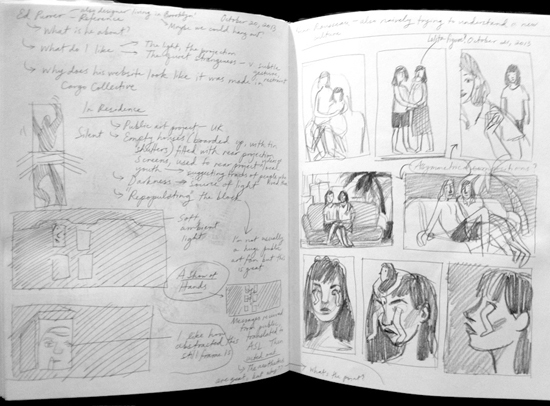"I don't know where to start. I am a very creative person who one day decided to borrow my friend's acrylic paints. I just started to blend and created something that was not that bad. Since then, I've felt encouraged to keep trying it. My question is, where do I start? I know nothing about art and I don't want to come off as a poser."
The visual arts are so incredibly broad that there is an overwhelming amount of options when you're just getting started. I would suggest starting with the one classic tool that artists throughout history have used: the sketchbook. Drawing is fundamental to every area of the visual arts, so any experience you have with drawing in your sketchbook will eventually contribute to your experience with other media. Drawing in a sketchbook keeps things very simple and accessible.
Sketchbook by Myles Dunigan.
Buy a small sketchbook, and carry your sketchbook around with you everywhere that you go. Be on a constant hunt for ideas and images. Any time you see something that excites you, draw it or write it down in your sketchbook. Think about your sketchbook as the ultimate resource for ideas and visuals; it should reflect the inner workings of your mind. Your sketchbook is the primordial soup for all of your creative pursuits. Everything in your sketchbook should be raw and unfiltered material that could some day emerge as a larger project.
The great thing about a sketchbook is there's no pressure to perfect or finish anything. Many artists get caught up in overworking their art because they are too precious about their work. In a sketchbook, you can draw freely without feeling like you need to live up to a set of expectations.
Sketchbook by Sara Bloem.
Commit to drawing something in your sketchbook everyday. Draw with simple materials like a pen, a pencil, colored pencils, etc. The simplicity of these materials will keep things straightforward and focused on the pure process of drawing. Date your drawings so that you can see your progress as you flip through past drawings in your sketchbook. Even if you only have time to do something quick, like a 10 minute sketch once a day, that time is still valid and will contribute to your overall progress. Spread out your work, it's better to sketch for a few minutes seven days a week, rather than to draw for three hours once a week.
Once you've been working in your sketchbook for a few months, you will be able to look back on your past drawings and start to figure out where you want to go from there. I love going back and looking through my old sketchbooks, they are visual archives of my creative process at the time. You will be able to watch your ideas and images evolve, and track your progress in this way. Your experience with your sketchbook will steer you towards more specific interests, and guide you to towards the next step.
Ask the Art Professor is a weekly advice column for visual artists. Submit your questions to clara(at)claralieu.com


